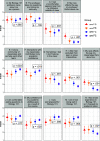Understanding Differences in Underrepresented Minorities and First-Generation Student Perceptions in the Introductory Biology Classroom
- PMID: 34804325
- PMCID: PMC8561840
- DOI: 10.1128/jmbe.00176-21
Understanding Differences in Underrepresented Minorities and First-Generation Student Perceptions in the Introductory Biology Classroom
Abstract
We used quantitative methods to better understand the perceptions of students in an introductory biology course (Biology 101) at a small, liberal arts college (SLAC) that is also a primarily white institution (PWI). In pre/post surveys, we asked students questions related to their attitudes and beliefs about their professor, classmates, and Biology 101. We were especially interested in the responses and outcomes of underrepresented minorities (URM) and first-generation (FG) students. Our findings suggest URM and FG students have a decreased sense of belonging and increased perceptions of exclusion and differential treatment due to race. These findings can explain, in part, the disparity in Biology 101 grade and STEM (science, technology, engineering, and math) attrition.
Keywords: attitude; disparities; first-generation; introductory biology; kindness cues; perception; stereotype threat; survey; underrepresented minorities.
Copyright © 2021 Jantzer et al.
Figures



Similar articles
-
Active Learning Outside the Classroom: Implementation and Outcomes of Peer-Led Team-Learning Workshops in Introductory Biology.CBE Life Sci Educ. 2016 fall;15(3):ar31. doi: 10.1187/cbe.16-01-0051. CBE Life Sci Educ. 2016. PMID: 27496361 Free PMC article.
-
Values Affirmation Intervention Reduces Achievement Gap between Underrepresented Minority and White Students in Introductory Biology Classes.CBE Life Sci Educ. 2017 Fall;16(3):ar41. doi: 10.1187/cbe.16-12-0351. CBE Life Sci Educ. 2017. PMID: 28710060 Free PMC article.
-
Closing achievement gaps with a utility-value intervention: Disentangling race and social class.J Pers Soc Psychol. 2016 Nov;111(5):745-765. doi: 10.1037/pspp0000075. Epub 2015 Nov 2. J Pers Soc Psychol. 2016. PMID: 26524001 Free PMC article. Clinical Trial.
-
Despite Similar Perceptions and Attitudes, Postbaccalaureate Students Outperform in Introductory Biology and Chemistry Courses.CBE Life Sci Educ. 2019 Mar;18(1):ar3. doi: 10.1187/cbe.17-12-0289. CBE Life Sci Educ. 2019. PMID: 30681902 Free PMC article.
-
Developing the ecological scientist mindset among underrepresented students in ecology fields.Ecol Appl. 2021 Sep;31(6):e02348. doi: 10.1002/eap.2348. Epub 2021 Jun 28. Ecol Appl. 2021. PMID: 34181297 Free PMC article. Review.
Cited by
-
"No matter what your story is, there is a place for you in science": Students' Ability to Relate to Scientists Positively Shifts after Scientist Spotlight Assignments, Especially for First-Generation Students and Women.CBE Life Sci Educ. 2023 Mar;22(1):ar12. doi: 10.1187/cbe.22-06-0103. CBE Life Sci Educ. 2023. PMID: 36696139 Free PMC article.
-
How researchers calculate students' grade point average in other courses has minimal impact.PLoS One. 2023 Aug 18;18(8):e0290109. doi: 10.1371/journal.pone.0290109. eCollection 2023. PLoS One. 2023. PMID: 37594958 Free PMC article.
-
Summer Research Internship Curriculum to Promote Self-Efficacy, Researcher Identity, and Peer-to-Peer Learning: Retrospective Cohort Study.JMIR Form Res. 2025 Feb 3;9:e54167. doi: 10.2196/54167. JMIR Form Res. 2025. PMID: 39899006 Free PMC article.
References
-
- Gibbs Jr K. 2014. Diversity in STEM: what it is and why it matters. https://blogs.scientificamerican.com/voices/diversity-in-stem-what-it-is....
-
- Rock D, Grant H. 2016. Why diverse teams are smatter. https://hbr.org/2016/11/why-diverse-teams-are-smarter.3.
-
- Jackson SE, Joshi A. 2011. Work team diversity, p 651–686. In Zedeck S. (ed), APA handbook of industrial and organizational psychology, vol. 1. Building and developing the organization. American Psychological Association, Washington, DC.
-
- U.S. Department of Commerce, Census Bureau. Current population survey (CPS), October supplement, 2000, 2010, and 2017, table 306.30. https://nces.ed.gov/programs/digest/d18/tables/dt18_306.30.asp?referrer=....
LinkOut - more resources
Full Text Sources
